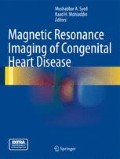Abstract
Magnetic resonance imaging (MRI) is a safe diagnostic tool and over 500 million diagnostic studies have been performed safely up to now. However, there have been at least 15 published cases of patient deaths associated with MRI scanning; 10 cases with implanted pacemakers [1–5], 2 patients with an insulin pump [3], 1 patient with a neuro-stimulator, 1 patient with an aneurysm clip [6], and 1 child killed by an oxygen tank [7]. Additionally, hundreds of severe burns [8] or injuries due to ferromagnetic projectiles have also been reported. The loud noises (up to 120 dBA) induced by the fast switching gradient fields make ear protections mandatory for all patient. The sources of all these risks are the electromagnetic fields of the MRI scanner.
Access this chapter
Tax calculation will be finalised at checkout
Purchases are for personal use only
References
Irnich W, et al. Do we need pacemakers resistant to magnetic resonance imaging? Europace. 2005;7(4):353–65.
Duru F, et al. Pacing in magnetic resonance imaging environment: clinical and technical considerations on compatibility. Eur Heart J. 2001;22(2):113–24.
The Joint Commission. Preventing MRI accident and injuries. Sentinel Event Alert, 14 Feb 2008.
Avery JK. Loss prevention case of the month. Not my responsibility! J Tenn Med Assoc. 1988;81(8):523.
Schiebler M, Kaut-Watson C, Williams DL. Both sedated and critically ill require monitoring during MRI (survey).MR. 1994;Winter:41–5.
Klucznik RP, et al. Placement of a ferromagnetic intracerebral aneurysm clip in a magnetic field with a fatal outcome. Radiology. 1993;187(3):855–6.
Boy, 6, Dies of skull injury during M.R.I. The New York Times, 31 July 2001.
Hardy 2nd PT, Weil KM. A review of thermal MR injuries. Radiol Technol. 2010;81(6):606–9.
ACR. ACR manual on contrast media (Version 8), American College of Radiology, Editor; 2012. Available from: http://www.acr.org/Quality-Safety/Resources/Contrast-Manual. Accessed on 9, 2012).
Chakeres DW, et al. Effect of static magnetic field exposure of up to 8 Tesla on sequential human vital sign measurements. J Magn Reson Imaging. 2003;18(3):346–52.
Price DL, et al. Investigation of acoustic noise on 15 MRI scanners from 0.2 T to 3 T. J Magn Reson Imaging. 2001;13(2):288–93.
Kugel H, et al. Hazardous situation in the MR bore: induction in ECG leads causes fire. Eur Radiol. 2003;13(4):690–4.
Patel MR, et al. Acute myocardial infarction: safety of cardiac MR imaging after percutaneous revascularization with stents. Radiology. 2006;240(3):674–80.
Shellock FG. Reference manual for magnetic resonance safety, implants, and devices, 2011 edition. Los Angeles: Biomedical Research Publishing Group; 2011.
Levine GN, et al. Safety of magnetic resonance imaging in patients with cardiovascular devices: an American heart association scientific statement from the committee on diagnostic and interventional cardiac catheterization, council on clinical cardiology, and the council on cardiovascular radiology and intervention: endorsed by the American college of cardiology foundation, the North American society for cardiac imaging, and the society for cardiovascular magnetic resonance. Circulation. 2007;116(24):2878–91.
Wilkoff BL, et al. Magnetic resonance imaging in patients with a pacemaker system designed for the magnetic resonance environment. Heart Rhythm. 2011;8(1):65–73.
Sommer T, et al. Strategy for safe performance of extrathoracic magnetic resonance imaging at 1.5 Tesla in the presence of cardiac pacemakers in non-pacemaker-dependent patients: a prospective study with 115 examinations. Circulation. 2006;114(12):1285–92.
Shinbane JS, Colletti PM, Shellock FG. MR in patients with pacemakers and ICDs: defining the issues. J Cardiovasc Magn Reson. 2007;9(1):5–13.
Naehle CP, et al. Safety, feasibility, and diagnostic value of cardiac magnetic resonance imaging in patients with cardiac pacemakers and implantable cardioverters/defibrillators at 1.5 T. Am Heart J. 2011;161(6):1096–105.
Luechinger R. In vivo heating of pacemaker leads during magnetic resonance imaging. Eur Heart J. 2005;26(4):376–83. discussion 325–7.
Luechinger R, et al. Safety considerations for magnetic resonance imaging of pacemaker and ICD patients. Herzschr Elektrophys. 2004;15(1):73–81.
Roguin A, et al. Magnetic resonance imaging in individuals with cardiovascular implantable electronic devices. Europace. 2008;10:336–743.
Kanal E, et al. ACR guidance document for safe MR practices: 2007. AJR Am J Roentgenol. 2007;188(6):1447–74.
Cowper SE, et al. Scleromyxoedema-like cutaneous diseases in renal-dialysis patients. Lancet. 2000;356(9234):1000–1.
Grobner T. Gadolinium – a specific trigger for the development of nephrogenic fibrosing dermopathy and nephrogenic systemic fibrosis? Nephrol Dial Transplant. 2006;21(4):1104–8.
FDA. FDA drug safety communication: new warnings for using gadolinium-based contrast agents in patients with kidney dysfunction. 2010. Available from: http://www.fda.gov/Drugs/DrugSafety/ucm223966.htm. Accessed on 9, 2012.
Wahl A, et al. Safety and feasibility of high-dose dobutamine-atropine stress cardiovascular magnetic resonance for diagnosis of myocardial ischaemia: experience in 1000 consecutive cases. Eur Heart J. 2004;25(14):1230–6.
Karamitsos TD, et al. Feasibility and safety of high-dose adenosine perfusion cardiovascular magnetic resonance. J Cardiovasc Magn Reson. 2010;12:66.
Kramer CM, et al. Standardized cardiovascular magnetic resonance imaging (CMR) protocols, society for cardiovascular magnetic resonance: board of trustees task force on standardized protocols. J Cardiovasc Magn Reson. 2008;10:35.
Author information
Authors and Affiliations
Corresponding author
Editor information
Editors and Affiliations
Rights and permissions
Copyright information
© 2012 Springer-Verlag London
About this chapter
Cite this chapter
Luechinger, R. (2012). MRI Safety. In: Syed, M., Mohiaddin, R. (eds) Magnetic Resonance Imaging of Congenital Heart Disease. Springer, London. https://doi.org/10.1007/978-1-4471-4267-6_2
Download citation
DOI: https://doi.org/10.1007/978-1-4471-4267-6_2
Published:
Publisher Name: Springer, London
Print ISBN: 978-1-4471-4266-9
Online ISBN: 978-1-4471-4267-6
eBook Packages: MedicineMedicine (R0)

